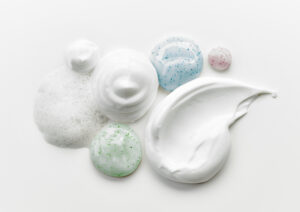Hello to our community of cosmetic and skincare experts! Emulsifiers, as we all know, are the unsung heroes in many of our favorite products, ensuring water and oil play nicely together. But a pressing debate in the industry is whether to opt for natural or synthetic emulsifiers.
In this blog post, we’ll get a *little sciencey* to unpack the key differences between types of emulsion. In the end, you’ll have a clearer understanding of what you want to formulate with and why.
Let’s dive in – but first, as always, let’s level set on what we’re talking about here so that everyone is on the same page.
What Are Emulsifiers?

Hang tight – we’re about to get nerdy.
Emulsifiers are molecules with the unique ability to make water and oil miscible, creating a stable, homogeneous mixture called an emulsion. These molecules have a hydrophilic (water-attracting) and a hydrophobic (water-repelling) part. The hydrophobic tail buries itself in an oil droplet, while the hydrophilic head remains in the water phase, thus stabilizing the dispersion of oil in water or vice versa. Think of trying to mix oil and water in your kitchen. Without some form of binding agent, they simply won’t merge. That binding agent, in the world of cosmetics, is the emulsifier. It acts like the egg in mayonnaise, ensuring all ingredients blend smoothly.
The interesting thing is that emulsifiers are used in a number of industries (like food, for example), but for the purpose of this blog post, we’re sticking in the beauty realm.
If you’re still with us after that mouthful, let’s take a look at why emulsifiers came to be and why they’re still vital in the beauty industry today.
The Historical Context: Emulsifiers in Beauty & Skincare Industry
Emulsifiers have been utilized for centuries, with ancient Egyptians creating rudimentary emulsions using gum and beeswax. Cleopatra herself reportedly used a concoction of beeswax, rosewater, and essential oils as a moisturizing cream. Over time, as science and technology evolved, the ability to create more sophisticated, stable, and aesthetically pleasing emulsions advanced.
During the 20th century, with the growth of the cosmetic and skincare industry, the development and utilization of emulsifiers became pivotal.
The Modern Day Significance of Emulsifiers in Skincare & Cosmetics
Emulsifiers aren’t merely ingredients – they are pillars that support and elevate cosmetic and skincare formulations. Their role in ensuring stability, enhancing aesthetics, and delivering active ingredients underscores their indispensability in the beauty industry. Skincare and cosmetic companies utilize them for the following reasons:
Product Texture and Stability:
- Seamless Blend: Emulsifiers facilitate the blending of oil and water phases, which ordinarily would separate, creating a smooth, unified texture.
- Product Stability: They ensure that formulations remain stable over time, preventing separation into distinct layers, thus preserving product integrity and extending shelf life.
Skin Feel and Aesthetic Appeal:
- Desirable Consistency: Emulsifiers impact the viscosity, providing products with a desired spreadable, non-greasy consistency.
- Aesthetic Quality: They allow for a luxurious feel and appearance, enhancing user experience, and ensuring consumer satisfaction.
Delivery of Active Ingredients:
- Efficient Delivery: Emulsifiers can assist in effectively delivering active ingredients, ensuring that they are uniformly distributed and can be adequately absorbed by the skin.
- Enhanced Skin Barrier Penetration: Certain emulsifiers may also enhance the penetration of active ingredients, optimizing their efficacy.

Diversity in Product Formulation:
- Versatility: Emulsifiers enable the creation of various product forms, from lotions and creams to serums and sprays, catering to diverse market needs.
- Formulation Compatibility: They can facilitate the incorporation of various additives like vitamins, sunscreens, and botanical extracts, creating multi-functional products.
Safety and Tolerance:
- Skin Tolerance: Emulsifiers can impact a formulation’s biocompatibility and ensure that products are gentle and well-tolerated by the skin.
- Preservation of Integrity: By maintaining a stable emulsion, they prevent the growth and spread of microbes, ensuring product safety.
With all of this in mind, there are two types of emulsifiers: natural and synthetic. Now that we’ve level set on what emulsifiers are, let’s get into the nitty gritty of these two distinctly different types of emulsification.
How Do You Create Natural and Synthetic Emulsifiers?
Synthetic emulsifiers are typically polyethylene glycols (PEG) derivatives, which involve esters, created through a reaction between sugar alcohol and fatty acid, followed by ethoxylation using ethylene oxide gas from fossil fuels. On the other hand, natural emulsifiers, like lecithin, derived from soy or sunflower and beeswax, undergo extraction and processing; some, such as lanolin, are derived from animals (sheep wool).

Beyond how they’re created, there are a number of other key differences. Let’s take a look at those.
4 Key Differences Between Natural and Synthetic Emulsifiers
While a lot of people will say that emulsifiers are all one in the same, they’d be wrong. This is not a “tom-ay-to” vs. “to-mah-to” conversation – there are a lot of key differences between synthetic and natural emulsifiers, including:
1. Consistency
Synthetic emulsifiers are the outcome of precise, controlled manufacturing processes. As a result, they promise consistency in composition, making them a predictable choice for formulators. For natural emulsifiers, drawing directly from nature implies a dance with its inherent unpredictability. This means batch-to-batch consistency can vary, which can pose challenges in formulating that perfect product.
2. Odor & Color Impact
Due to natural ingredients, natural emulsifiers might occasionally introduce subtle variations in odor and color to the end product, something formulators should be aware of. On the contrary, synthetic emulsifiers typically have a neutral profile, neither altering the product’s color nor adding any discernible scent.
3. Price Point & Availability
Natural emulsifiers often come with a heftier price tag due to their reliance on natural harvests, availability can sometimes be a concern, especially with unpredictable global events. Synthetic emulsifiers are ubiquitous and have the advantage of being readily available and more affordable, making them a go-to for many industries, not just cosmetics.
4. Texture & Formulation
Natural emulsifiers can be gentler on the texture, and to achieve the desired consistency, one might need to add natural additives like gums or fatty alcohols. This, of course, raises the intricate debate: What truly counts as “natural”? However, synthetic emulsifiers generally introduce a richer texture to the product, ensuring a creamier feel.
The Shift Away from Synthetic Emulsifiers in the Beauty Industry
Over recent years, the beauty industry has experienced a profound shift towards embracing natural ingredients in its products. Driven by consumer demand and a broader societal push for sustainability, many brands are reevaluating their ingredient lists and production processes. This movement isn’t merely about tapping into the perceived benefits of nature-derived components but also signifies a commitment to environmental responsibility, reduced carbon footprints, and ethical sourcing. One notable change in this green revolution is the exploration of natural emulsifiers in formulations. As emulsifiers play a pivotal role in the texture and consistency of products, finding natural alternatives that are both effective and sustainable aligns with the industry’s evolving ethos of combining beauty with responsibility.
A Natural Emulsifier that Doesn’t Sacrifice Synthetic Emulsifier Qualities
In the realm of natural emulsifiers, let’s consider Seabalance. It aligns beautifully with the industry’s increasing interest in upcycled products – made from sargassum seaweed, which is abundant and requires no concerns (like deforestation), Seabalance offers a unique stand-out quality. From a performance standpoint, its application gives a soft, silky touch to the skin without the oily effect, making it a favored choice in formulations. Plus, it boosts moisturization! Win win.

All and all, emulsifiers, whether natural or synthetic, hold the cosmetic world together, quite literally. As formulators and experts, understanding their nuances helps in making informed decisions that align with brand values and market demands. Formulators interested in exploring Seabalance for their cosmetic or skincare formulations can request a free sample!



